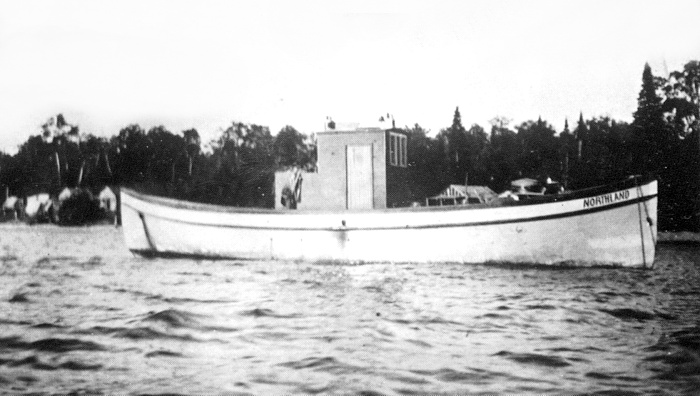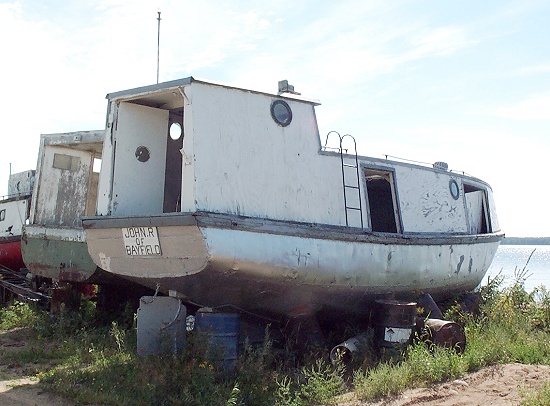Fish Tugs of the Greatest Lake
The
Evolution of Fish Boat Design
at Bayfield, Wisconsin
by Harvey
Hadland
PART TWO
When permanently enclosed
cabins became the accepted design, the forward deck and stern deck were
open. As most of the boats operated from island fishing stations, and
were moored in permanent anchors overnight, the open bow was a handy feature.
Windows, and a door on the front of the cabin, also enhanced visibility.

Open
decks: NORTHLAND at Rocky Island
Most of the boats during
these years were twenty-five to thirty foot in length. For many years
twenty-six feet was considered an ideal size. By the third decade of the
twentieth century, most all boats that were operating had adapted the
solid frame cabin, with varying sizes of side openings(gangways), but
no pilothouses. All steering, while underway, was done from the open stern
deck. The next evolutionary change was to go to a pilothouse over the
engine space, a great improvement from having to stand out in the open.
By the mid to late
1930s, larger boats, 35 to 40 feet in length, were being built. These
boats featured pilothouses amidship, and were housed in all the way to
the bow. By this time much of the fishing was on the outside banks, where
more severe weather was encountered, so what came to be known as a 'sprayhood'
bow was a necessary addition.

Midships
pilothouse and sprayhood bow: SOUTH TWIN on
display at Red Cliff.
In 1930 a new design
was introduced when the 35 ft. STRANGER was built. Ted Bainbridge had moved to Bayfield from Marinette, Wisconsin
in the late 1920s, and fished with his boat SILVER LEAF, a boat
much like the local boats. When he had his new boat built, he
adapted a design that was popular on Green Bay and Lake Michigan.The STRANGER was fully enclosed, featuring a raised pilothouse on the square stern,
the first boat of this design to be built at Bayfield.
Few local fishermen adapted this design, however. When they had new boats built, they stayed
with the open stern and midship pilothouse. It wasn't until the 1950s,
when some of the boats were rebuilt, that the stern pilothouse was adapted,
and indeed became popular.

Aft
pilothouse: JOHN R. at Bayfield, 2001.
The last boats to be
built locally, in the late 1940s, were still of the traditional open stern
type. By then the local builders were no longer in business. Fishermen
looking to acquire larger boats had to go to the lower lakes to find replacements
for their aging craft, and boat building became a thing of the past at
Bayfield.
All
contents copyright 2002-2016, Harvey Hadland and Bob Mackreth
|